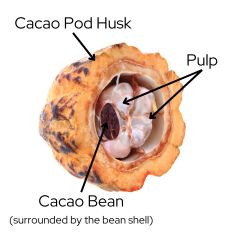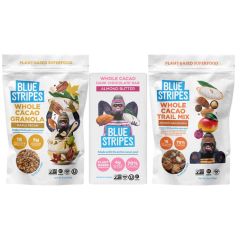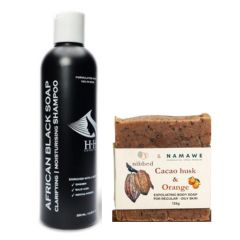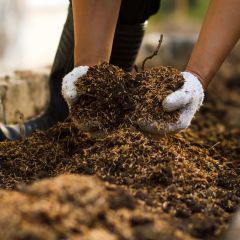
How can the Whole Cacao Pod be Upcycled? Cacao Pod Husks
Less than 30% of a whole cacao pod is used in the typical chocolate production process. Opportunities exist for cacao farmers to generate additional revenue streams from the rest of the pod and reduce food waste at the same time. In our first post, we highlighted opportunities to incorporate cacao fruit – the sweet white pulp surrounding cacao beans – into various drinks and foods. In part two of this series, we explore the broad range of uses for cacao pod husks.
The Cacao Pod Husk

The fibrous outer cacao pod husk is the largest part of the cacao pod by weight, accounting for over two-thirds of a pod at harvest time. Divided into three layers from the outside inward – the epicarp, the mesocarp and the endocarp, these together protect the cacao beans as they grow. The husk is rich in dietary fiber, lignin, bioactive antioxidants, and other components that could be used across multiple industries18.
Once the pulp-covered cacao beans are removed, the pod husk usually becomes a wasted byproduct. If left in the cacao field, diseased pods could threaten future yields by spreading black pod rot disease. Fields affected with this disease can see up to a 90% decline in production if left untreated1,15. Therefore, removing the pods can not only prevent or minimize the spread of the disease, but also create an additional income stream or provide a beneficial input for the farm.
Upcycled Products from Cacao Pod Husks

-
Flour for Baking: cacao pod husks can be dried and pulverized into a powder or flour used in food production. With its high fiber and water-soluble pectin content, cacao pod husk flour has been substituted for starch in sausages7,9 and added to bread to increase fiber content3. Blue Stripes Urban Cacao uses the husk as “Cacao Shell Fiber” in its chocolate bars, trail mix, and granola.
- Soap: dried cacao pod husks contain about 40% potash after they are burnt. This can be a source of alkali for soap making11. Cocoa Potash in Ghana produces caustic potash and potash fertilizer from cacao pod husks and then teaches women’s groups to make soap from potash. HH Cosmetics uses potash from cacao pod husks in its African Black Soap Shampoo.
- Bioenergy: both small-scale and large-scale projects to produce energy from cacao pod husks have been planned in West Africa. These include 5kW generation units in Ghana and a 75MW biomass power plant in Cote d’Ivoire13,16,20.

-
Bioactive Compounds: cacao pod husks contain valuable compounds that can be extracted for use in pharmaceuticals, nutraceuticals, and functional food products. The same bioactive compounds that provide dark chocolate with its health benefits are present in the cacao pod husk, making this byproduct a promising source of the following compounds:
- Dietary Fiber: cacao pod husks have a total dietary fiber content of about 35%10. High dietary fiber consumption is associated with a lower risk of many cardiovascular and gastrointestinal diseases as well as diabetes and obesity4. As such, there are efforts to encourage individuals to consume more dietary fiber, including through functional foods and supplements.
- Antioxidants: polyphenols, especially flavonoids, are found in cacao pod husks and can help improve cardiovascular health and protect against cancer6,10,12.
- Theobromine: this stimulant is similar to caffeine but also has properties that could be relevant for asthma and respiratory disease and cardiovascular health14. Theobromine is readily available as a supplement powder and was previously used in some pharmaceutical applications.
- Pectin: the pectin extracted from cacao pod husk may have biomedical application, especially for pharmaceutical formulation of controlled release drugs2,5.
- Phytosterols: these compounds help manage blood cholesterol levels and may help prevent obesity, diabetes and cancer8. Phytosterols are available in a dietary supplement.
On Farm Beneficial Uses for Cacao Pod Husks

- Animal Feed: animals like Nile tilapia, pigs, and goats have thrived on feed that includes wet or dried cocoa pod husks17. This points to a cost savings opportunity, especially for livestock farmers in cacao-growing regions or those willing to process cacao pod husks into a shelf stable additive for animal feed.
-
Compost: composting provides the opportunity to replace nutrients that were removed from the soil by crops without resorting to conventional fertilizer. The compost can be further enriched with animal manure or green manure (plant matter) to increase the overall nutrient content19. Hacienda Betulia is a cacao farm in Colombia that highlights its efforts to recycle cacao pod husks through worm composting.
- Biochar: like compost, biochar is a soil amendment that adds nutrients back into the soil. Created by burning the cacao pod husks with limited air exposure, biochar improves moisture retention in soil and is slower to break down than compost19.
Untapped Potential
Although we have highlighted diverse opportunities to use cacao pod husks in food, energy production, personal care, and animal feed, the reality is that most cacao pod husks are not generating additional revenue for farmers. Some potential uses are still mainly academic. Others require large investments in infrastructure to process cacao pod husks at origin. In contrast to cacao fruit, which food entrepreneurs in origin countries and around the world are using in new ways, cacao pod husks remain very underutilized. This points both to the challenge of value-added processing in cacao-growing communities and to the market access needed to achieve the desired financial, social, and environmental impact at scale.
References
- Adeniyi, D. & Asogwa, E. U. “Complexes and Diversity of Pathogens and Insect Pests of Cocoa Tree.” 2023. Forest Microbiology. https://doi.org/10.1016/B978-0-443-18694-3.00002-X.
- Adi-Dako, O., Ofori-Kwakye, K., Edem Kukuia, K. K., Asiedu-Larbi, J., Kwadwo Nyarko, A., Kumadoh, D. & Frimpong, G. “Cocoa Pod Husk Pectin Intended as a Pharmaceutical Excipient Has No Adverse Effect on Haematological Parameters in Sprague Dawley Rats.” 2018. Journal of Pharmaceutics. https://doi.org/10.1155/2018/1459849.
- Amir, I. Z., Hanida, H. S., & Syafiq, A. “Development and Physical Analysis of High Fiber Bread Incorporated with Cocoa (Theobroma cacao ) Pod Husk Powder.” 2012. International Food Research Journal.
- Anderson, J. W., Baird, P., Davis Jr., R. H., Ferreri, S., Knudtson, M., Koraym, A., Waters, V. & Williams, C. L. “Health Benefits of Dietary Fiber. 2009. Nutrition Reviews. https://doi.org/10.1111/j.1753-4887.2009.00189.x.
- Barrios-Rodriguez, Y.F., Salas-Calderon, K. T., Orozco-Blanco, D. A., Gentile, P. & Giron-Hernandez, J. “Cocoa Pod Husk: A High-Pectin Source with Applications in the Food and Biomedical Fields.” 2022. ChemBioEng Reviews. https://doi.org/10.1002/cben.202100061.
- Belwal, T., Cravotto, C., Ramola, S., Thakur, M., Chemat, F., & Cravatto, G. “Bioactive Compounds from Cocoa Husk: Extraction, Analysis and Application in Food Production Chain.” 2022. https://doi.org/10.3390/foods11060798.
- Choi, J., Kim, N., Choi, H. Y. & Han, Y. S. “Effect of Cacao Bean Husk Powder on the Quality Properties of Pork Sausages.” 2019. Food Science of Animal Resources. https://doi.org/10.5851/kosfa.2019.e62.
- Cleveland Clinic. “Phytosterols. https://my.clevelandclinic.org/health/drugs/17368-phytosterols-sterols--stanols.
- Delgado-Ospina, J., Martuscelli, M., Grande-Tovar, C. D., Lucas-Gonzalez, R., Molina-Hernandez, J. B., Viuda-Martos, M., Fernandez-Lopez, J., Perez-Alvarez, J. A. & Chaves-Lopez, C. “Cacao Pod Husk Flour as an Ingredient for Reformulating Frankfurters: Effects on Quality Properties.” 2021. https://doi.org/10.3390/foods10061243.
- Delgado-Ospina, J. Lucas-Gonzalez, R., Viuda-Martos, M., Fernandez-Lopez, J., Perez-Alvarez, J.A., Martuscelli, M. & Chaves-Lopez, C. “Bioactive Compounds and Techno-Functional Properties of High-Fiber Co-Products of the Cacao Agro-Industrial Chain.” 2021. https://doi.org/10.1016/j.heliyon.2021.e06799.
- Gyedu-Akoto, E., Yabani, D., Sefa, J. & Owusu, D. “Natural Skin-care Products: The Case of Soap Made from Cocoa Pod Husk Potash.” 2015. Advances in Research. https://doi.org//10.9734/AIR/2015/17029.
- “What are Polyphenols? Types, Benefits, and Food Sources. https://www.healthline.com/nutrition/polyphenols.
- Kilama, G., Lating, P. O., Byaruhanga, J. & Biira, S. “Quantification and Characterization of Cocoa Pod Husks for Electricity Generation in Uganda.” 2019. Energy, Sustainability and Society. https://doi.org/10.1186/s13705-019-0205-4.
- Martinez-Pinilla, E., Onatibia-Astibia, A. & Franco, R. “The Relevance of Theobromine for the Beneficial Effects of Cocoa Consumption.” 2015. Frontiers in Pharmacology. https://doi.org/10.3389/fphar.2015.00030.
- Munongo, M. E., Nkeng, G. E. & Njukeng, J. N. “Production and Characterization of Compost Manure and Biochar from Cocoa Pod Husks.” 2017. International Journal of Advanced Scientific Research and Management. https://ijasrm.com/wp-content/uploads/2017/02/IJASRM_V2S1_185_26_31.pdf.
- Njeru, G. “The Powerful New Use for Cocoa.” 2021. British Broadcasting Corporation. https://www.bbc.com/future/article/20210607-a-chocolatey-sustainable-alternative-to-fossil-fuels.
- Oddoye, E.O.K, Agyente-Badu, C.K. & Gyedu-Akoto, E. “Cocoa and its By-Products: Identification and Utilization.” 2013. Chocolate in Health and Nutrition. 23-37. https://doi.org/10.1007/978-1-61779-803-0.
- Ouattara, L. Y., Kouassi, E. K. A., Soro, Y., Yao, K. B., Adouby, K., Drogui, A. P., Tyagi, D. R. & Aina, P. M. 2021. "Cocoa Pod Husks as Potential Sources of Renewable High-Value-Added Products: A Review of Current Valorizations and Future Prospects," BioResources, 16(1), 1988-2020. https://doi.org/10.15376/biores.16.1.Ouattara.
- Research Technical Assistance Center. “Using Cocoa Pod Husks to Improve Crop Yields and Soil Quality.” 2019. https://www.prb.org/resources/using-cocoa-pod-husks-to-improve-crop-yields-and-soil-quality/
- Unwin, J. “Using Cocoa Husks to Create Power in Ghana.” 2019. Power Technology. https://www.power-technology.com/features/using-cocoa-husks-to-create-power-in-ghana/?cf-view.


4 comments
Tôi muốn có được tài liệu phương pháp chế biến vỏ ca cao thành phân bón nông nghiệp hữu cơ. Bạn có thể giúp tôi không
Kết nối giá trị nông nghiệp
I am a chemist with interest in green chemistry and waste conversion to wealth. I am interested in tapping this resources in both research and processing.
Prof. Adeoye Moriam Dasola
We are in the process of planting 100 acres in Fiji .
Can you please provide onsite on the equipment required to turn Cacaco husk into flour
Malcolm Herbert
I am interested in learning to transform cocoa pod husk as I want to start a small transformation unit .
Apostle Blaise Nana
Leave a comment
This site is protected by hCaptcha and the hCaptcha Privacy Policy and Terms of Service apply.